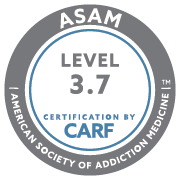Bipolar disorder is one of the most common forms of mental illness. Bipolar disorder is characterized by extreme mood swings (manic episodes or depression). These mood swings can be extremely debilitating and disruptive in day-to-day life. As a lifelong disease, bipolar disorder can be a disheartening and complicated disorder. However, there are treatment methods like ECT for bipolar disorder that can help relieve some of the symptoms.
Electroconvulsive therapy (ECT) is one of the possible options for combating the symptoms of bipolar disorder. It has been known to reverse some of the effects of certain mental disorders. While ECT may not be for everyone, there is an argument for how it can help with bipolar disorder cases. It’s important to speak with a medical professional before rushing into procedures like ECT.
While having bipolar disorder can be a crippling situation, especially if it’s paired with drugs or alcohol. No matter how bad things may get, it’s important to know that you don’t have to go through it alone. At New Directions for Women we’ve helped thousands of women get to a better place — both mentally and physically. Don’t be afraid to reach out for help today.
What is Bipolar Disorder?
Bipolar disorder is a disorder that’s described as extreme mood swings. These mood swings can include periods of mania (high energy and euphoria) and depression (sadness and hopelessness). These swings can occur frequently or rarely, this depends on a case-by-case basis. These intense swings can be exhausting and can be very stressful to deal with. 
Treating bipolar disorder typically takes therapy and medication in some cases (to relieve some of the symptoms). Over the years, new advancements and treatment options have emerged through research. ECT for bipolar disorder is an option that many women might not know about. While it may not fit every case of bipolar disorder, it may be an option after some research.
What is Electroconvulsive Therapy (ECT)?
Electroconvulsive therapy is a procedure in which small electric currents pass through a person’s brain. This is usually done under general anesthesia. While these electric currents pass through a person’s brain, a brief seizure is triggered. ECT has been shown to change the brain’s chemistry resulting in some symptoms of mental health conditions being reversed.
ECT normally works when someone has tried other unsuccessful treatment methods. It can also be used after a person has completed their treatment in its entirety. ECT for bipolar disorder can be a valid option in some scenarios. This all depends on the severity of the case and medical history.
Some of the stigmas associated with ECT are due to the high dose of electricity (without anesthesia) that were used in early treatments, long ago. This was a much more careless and risky way of treatment that has since evolved. Doing ECT without anesthesia or at such a high dose of electricity caused memory loss, fractured bones, and other effects. ECT is now much safer and more controlled. While ECT for bipolar disorder does still have a chance of causing side effects, under supervision the goal is to achieve the most benefit with the least possible risks.
What ECT is Used For?
When done correctly, ECT can result in fast and great improvements for some of the most severe symptoms (of mental illness). ECT can be used to treat multiple different symptoms, including:
- Severe depression: This can include suicidal thoughts, detachment from reality (psychosis), and other negative effects
- Severe mania: Associated with bipolar disorder, severe mania causes a state of severe euphoria. This can be paired with hyperactivity, agitation, impulsivity, risky behavior, drug abuse, psychosis, and impaired judgment
- Agitation/aggression (dementia cases): Dementia cases often include aggression and agitation which can impact a person’s life and wellbeing
- Depression that doesn’t improve with treatment: Some cases of depression can be so intense that treatment does not help it
- Catatonia: Catatonia occurs through lack of movement, strange, or speedy movements. Along with these specific symptoms is lack of speech and other symptoms. Catatonia is linked with cases of schizophrenia and other psychiatric cases.
ECT for bipolar disorder and other mental disorders can be effective if medications aren’t an option or therapy hasn’t worked. ECT can be used in the following cases:
- In cases where older adults aren’t able to take certain drugs
- A history of ECT working in the past
- In women who are pregnant and can’t take medication
- In cases where a person may prefer ECT over traditional medication
Some of the Risks of ECT
While ECT is considered safe and effective at times, there is some risk for some side effects. ECT for bipolar disorder can be very effective and outweighs some of the possible side effects that may emerge. Some of these risks may include:
Memory Loss
There is a slight chance that a person may have trouble remembering what happened moments before treatment, or maybe a few weeks/months back. In very rare cases a person may have trouble remembering things from years ago. The scientific term for this condition is retrograde amnesia. While this may sound concerning, these memory issues typically improve shortly after treatment finishes.
Confusion
In some cases, a person may feel confused immediately after treatment. This can continue for a few minutes up to a few hours. A person may not understand why they are there or where they are. In rare cases, a person may stay confused for a few days. Confusion may be more common with older adults.
Physical Effects
Feeling nausea, headaches, jaw pains, or muscle aches is normal after ECT treatment. Typically, these aren’t too severe and can be treated with medication.
Other Medical Complications
Medical procedures can be complex and may have complications during the journey (especially when anesthesia is involved). During the ECT process, a person may experience increased blood pressure and heart rate which may lead to heart problems. ECT is much riskier if you already have existing heart issues.
What to Expect During the ECT Process
Before the ECT for bipolar disorder or any other disorders, an evaluation will be determined. During this evaluation, you will provide: your medical history, a physical exam, a psychiatric assessment, take a basic blood test, ECG to check heart health, and a rundown of the risks of anesthesia.
After you have been accessed and it’s been determined that ECT is a good option for you, you will move onto the treatment. ECT takes about five to 10 minutes tops (this doesn’t include preparation and recovery time). ECT can be done in a hospital setting or as an outpatient procedure.
You will be given anesthesia and a muscle relaxant to help prevent injury and minimize the brief seizure. Other medication may be used depending on your current case. After, you’ll be given a blood pressure cuff for your foot (to monitor movements and seizure activity) along with an oxygen mask, and a mouth-guard to protect your teeth and tongue. After, the electric current is passed through an ECT machine. The process takes about 60 seconds tops.
After the effects of anesthesia and the muscle relaxer have worn off you’re taken to a recovery area. As mentioned before, you may experience some confusion or memory problems momentarily.
How Often Is ECT Used?
ECT treatments are given two to three times a week for three to four weeks — six to 12 treatments in total. The rate of these treatments typically depends on how severe your symptoms are and how rapidly they improve. These numbers will vary from person to person.
A person can return to regular daily activities just a few hours after the procedure is done. However, it may be advised to refrain from work, driving, or other activities until all treatments have finished. This can be one or two weeks after the final procedure. Additionally, returning to normal activities is dependent on when memory loss/confusion is resolved.
How Effective is ECT for Bipolar Disorder?
ECT for bipolar depends primarily on the person and their case. So how long does ECT take to work? Many people usually experience improvements after six or so treatments with ECT. Fully overcoming these symptoms may take longer. ECT may not work for everyone and may have some risks involved in the process. However, ECT has been shown to change some of the chemical components of the brain after seizure activity. When used in a medical environment, this brief seizure can end up relieving some of the symptoms involved with mental illnesses like bipolar disorder.
Getting Treatment Help at New Directions for Women
If you or a loved one is struggling with bipolar disorder or an addiction, New Directions for Women is here to help. Even if ECT for bipolar disorder doesn’t match your path, one of our trusted treatment options surely will. We’ve helped thousands of women overcome addiction and improve their mental health along the way. Start your journey now. Contact us today to learn about our addiction treatment options and resources with you in mind.












